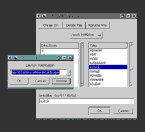| One of the
first things that many new Linux users look for is an IRC (Internet Relay Chat) client
with a graphical interface. Although classic screen-based applications such as irc-ii,
Epic and Bitchx continue to prove superior, increasing efforts are now being put into the
development of X clients for this popular chat system. Developed by Peter Zelezny, X-Chat is a very usable GTK
based IRC client with a similar look and feel to AmIRC.
When launched, a server list window is displayed.
This allows you to set a nickname (and two backups in case the first is taken), username
and account name. A list of default servers is provided which may be configured with an
initial channel, port number, password and comment. To connect to a server, simply select
one from the list (or add one) and press the connect button.
Once connected, you can obtain a listing of
publicly available channels with a handy channel list window, which also allows you to
specify a minimum number of users on channels to be listed. A text box at the bottom of
the main window allows you to enter a selection of standard irc-ii commands, so you can
just type /join #channel if needed. This command box is also where you type in general
chat text.
After joining a channel, the text will scroll up
the main window as per standard IRC clients, and you may configure some things such as the
foreground and background colours and fonts. A window on the right-hand side displays a
list of users on the current channel, indicating their status (a green dot next to the
nickname means they have channel 'ops'). You may select users individually from this list
for private chat, file transfer and various probings such as ping times and 'whois'
information.
Multiple channels may be managed,
with each channel selectable from the main window using a tabbed interface. When a channel
is active and you're not looking at it, the tab for that channel displays the channel name
in red so you can quickly switch to see what's happening there.
X-Chat also allows you to
connect to more than one server, and displays the current channel and server in the title
bar of the X window.
This is a very clean and simple IRC client for X.
Although it has a few annoying bugs and lacks extensive features, X-Chat is under active
development and appears to be evolving into a solid, useful application. |



